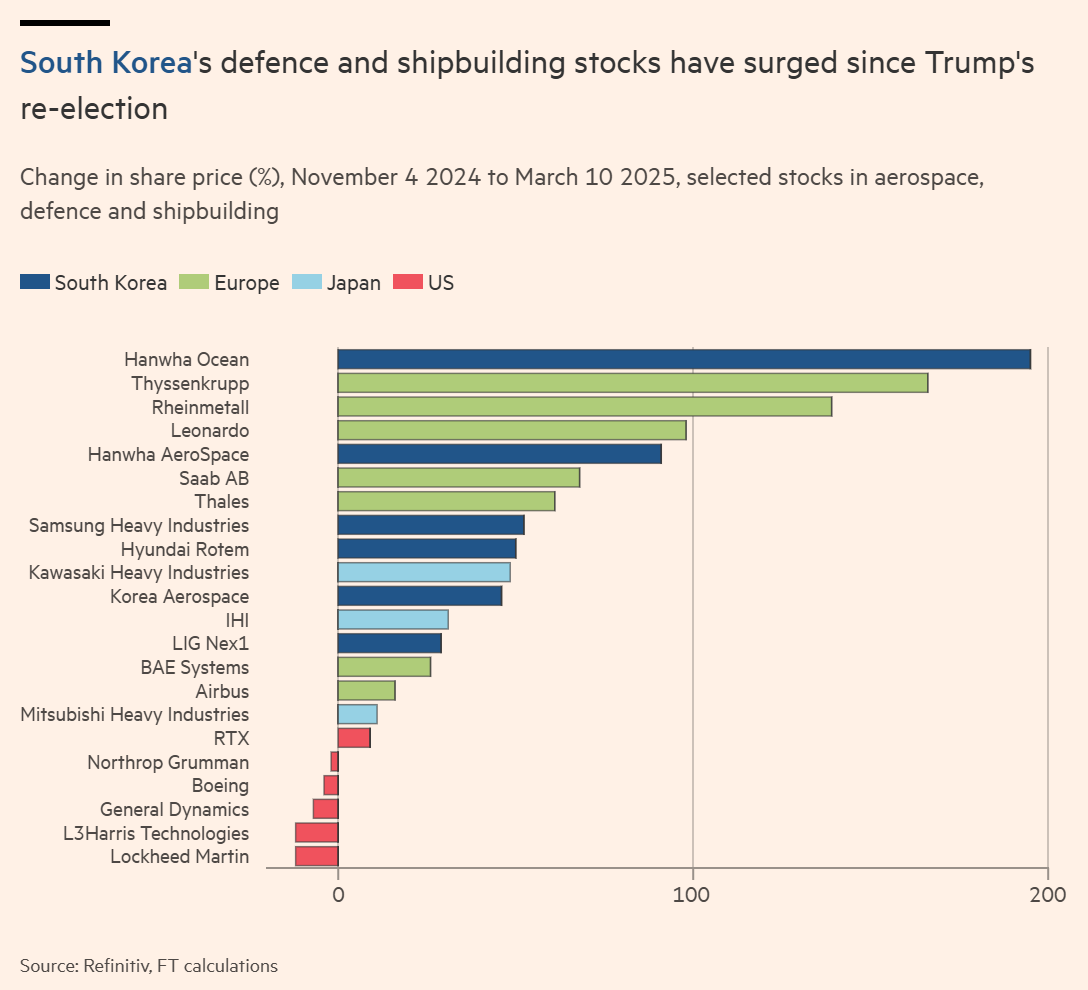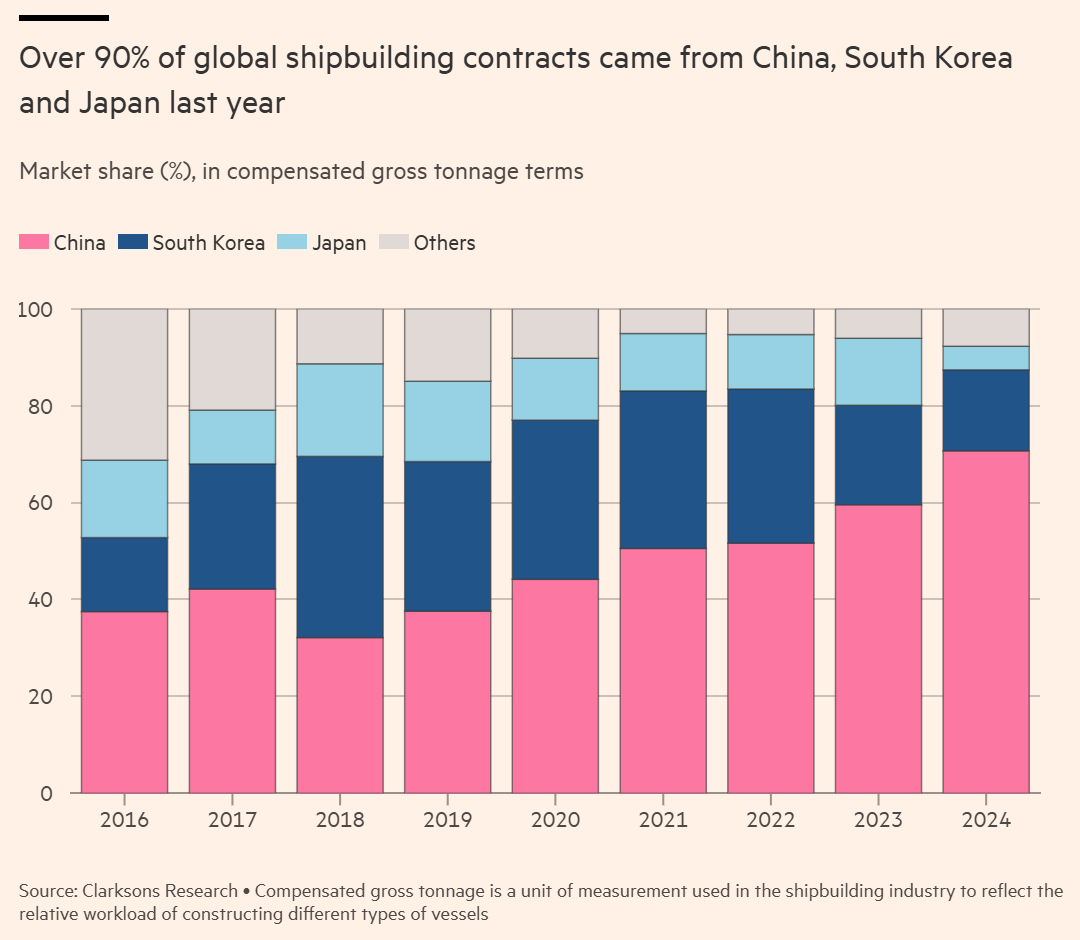Warren Buffett’s Berkshire Hathaway lifts stakes in Japanese trading houses
- https://www.ft.com/content/a267a933-0e6d-4091-bcb1-ddbb1bbf0cab
Warren Buffett’s Berkshire Hathaway has increased its shareholdings in Japan’s five biggest trading houses after negotiating to remove a 10 per cent ceiling for its investment in businesses known for trading everything from noodles to natural resources.
The US investment conglomerate raised its stake in Mitsubishi Corporation from 8.31 per cent to 9.67 per cent, and in Mitsui from 8.09 per cent to 9.82 per cent, according to filings with Japan’s securities regulator published on Monday. It also lifted its stake in Itochu, Marubeni and Sumitomo Corporation by about a percentage point.
The trading houses are vital to Japan as importers of raw materials such as oil, gas, iron ore and copper and for supporting the country’s car, electronics and machinery export sectors.
Buffett first disclosed Berkshire’s investments in the trading houses in 2020 and said in his annual shareholder letter last month that his “admiration for these companies has consistently grown”.
But he cautioned that the positive impact of Buffett’s investments would be counteracted by hurdles for the companies, including softening prices for commodities in which they are invested, high interest rates and the impact of inflation on consumer spending in Japan.
워렌 버핏의 버크셔 해서웨이는 국수부터 천연자원에 이르기까지 모든 것을 거래하는 것으로 알려진 기업들에 대한 투자에 10% 상한선을 없애기로 협상한 후 일본 5대 종합상사의 지분율을 높였습니다.
월요일에 발표된 일본 증권 규제 당국에 제출된 서류에 따르면, 미국 투자 지주회사는 미쓰비시상사의 지분을 8.31%에서 9.67%로, 미쓰이물산의 지분을 8.09%에서 9.82%로 늘렸습니다. 또한 이토추상사, 마루베니, 스미토모상사의 지분도 약 1%포인트씩 늘렸습니다.
이 종합상사들은 석유, 가스, 철광석, 구리와 같은 원자재 수입업체로서, 그리고 일본의 자동차, 전자제품, 기계 수출 부문을 지원하는 데 중요한 역할을 합니다.
버핏은 2020년에 이 종합상사들에 대한 버크셔의 투자를 처음 공개했으며, 지난달 연례 주주 서한에서 “이 회사들에 대한 존경심이 꾸준히 커져왔다”고 말했습니다.
그러나 그는 버핏의 투자가 긍정적인 영향을 미치더라도, 투자된 상품의 가격 하락, 높은 금리, 일본의 소비자 지출에 대한 인플레이션 영향 등 회사들이 직면한 장애물로 인해 상쇄될 수 있다고 경고했습니다.
The costly end of Europe’s ‘peace dividend’
- https://www.ft.com/content/cf1638c4-45ed-4671-8c42-3136e7bda7d5
European countries collectively saved hundreds of billions of euros a year in recent decades — a postwar “peace dividend” — as they drove down defence spending and freed up resources for other priorities including their welfare states.
They now face a brutal reckoning as they embark on a dash for re-militarisation after President Donald Trump threatened to scale back US support for the continent.
While the EU spends slightly less than 2 per cent of its GDP on defence today, European leaders are openly debating lifting spending to as much as 3.5 per cent of GDP or higher in the coming decade, a level not seen in continental Europe since the late 1960s.
Spending at this level between 1995 and 2023 would have required EU member states to allocate an extra $387bn a year to defence, according to Financial Times calculations based on 2020 purchasing power parity (PPP) dollars. The uplift for the UK, which spent 2.3 per cent of GDP on defence in 2023, would have been $35bn a year over the same period — roughly equivalent to annual public spending on housing and local amenities.
Europe enjoyed its years of low military spending thanks to a prolonged period of protection from the US, allowing it to build one of the most generous social security systems in the world for an ageing population.
Across the EU, social protection has grown as a share of total government spending, rising from 36.6 per cent in 1995 to 41.4 per cent on the eve of the pandemic, according to Eurostat.
유럽 국가들은 최근 수십 년 동안 국방비를 줄이고 복지 국가를 포함한 다른 우선순위에 자원을 투입하면서 매년 수천억 유로를 절약했습니다. 이는 전후 “평화 배당금”이었습니다.
그러나 도널드 트럼프 대통령이 유럽 대륙에 대한 미국의 지원을 축소하겠다고 위협하면서, 유럽은 재군비 경쟁에 나서면서 이제 혹독한 대가를 치르게 되었습니다.
현재 EU는 GDP의 2% 미만을 국방에 지출하고 있지만, 유럽 지도자들은 향후 10년 안에 GDP의 3.5% 이상으로 지출을 늘리는 것을 공개적으로 논의하고 있습니다. 이는 1960년대 후반 이후 유럽 대륙에서 볼 수 없었던 수준입니다.
파이낸셜 타임즈의 2020년 구매력 평가(PPP) 달러 기준 계산에 따르면, 1995년부터 2023년까지 이 수준으로 지출했다면 EU 회원국들은 연간 3,870억 달러를 국방에 추가로 할당해야 했을 것입니다. 2023년에 GDP의 2.3%를 국방에 지출한 영국의 경우, 같은 기간 동안 연간 350억 달러의 추가 지출이 필요했을 것입니다. 이는 주택 및 지역 편의 시설에 대한 연간 공공 지출과 거의 동일한 금액입니다.
유럽은 미국의 오랜 보호 덕분에 낮은 군비 지출을 누릴 수 있었고, 이를 통해 고령화 사회를 위한 세계에서 가장 관대한 사회 보장 시스템 중 하나를 구축할 수 있었습니다.
유로스타트에 따르면 EU 전체에서 사회 보호는 총 정부 지출에서 차지하는 비중이 증가하여 1995년 36.6%에서 팬데믹 직전 41.4%로 증가했습니다.
- 미국의 압도적인 방위력에 의존한 것은 사실
- 그 돈으로 세금 올리고 복지정책해서 등따숩고 배부르게…
- 미국 입장에선 삔또가 나갈만 하다
- 그러나 서방세계가 그렇게 노력해서 최소 본토에서는 반세기 가까운 기간 동안 전쟁이 없었으니, 이 역시 무언가 성취한 것이 아닐까
- 메르켈의 큰 그림은 어디서 어떻게 부서지기 시작했는지 모르겠지만, 안타깝다
Cutting government spending on pensions and healthcare will be particularly challenging, as Europe’s population is the oldest of any continent, meaning social spending will grow and revenues fall as the working age population shrinks.
유럽의 인구가 모든 대륙 중에서 가장 고령화되어 사회적 지출은 증가하고 노동 가능 인구가 감소함에 따라 세수는 줄어들기 때문에, 정부의 연금 및 의료비 지출을 줄이는 것은 특히 어려운 과제가 될 것입니다.
Alphabet spins off laser-based internet project from ‘moonshot’ hub
- https://www.ft.com/content/1331c131-7b89-47ab-8dd2-3ce6c6a2307a
Alphabet is spinning out laser-based internet company Taara from its “moonshot” incubator, hoping to turbocharge the start-up that provides high-bandwidth services to hard-to-reach areas in competition with Elon Musk’s Starlink network of satellites.
Taara is the latest project to spring from X — Alphabet’s experimental hub that produced artificial intelligence lab Google Brain and Waymo’s self-driving cars — and has its origins in a concept called Loon. That envisaged shooting beams of light between thousands of balloons floating on the edge of space to provide phone and internet services across remote areas.
The technology works by firing a beam of light the width of a pencil from one traffic light-sized terminal to another, using a system of sensors, optics and mirrors to fix it on a 1.5 inch receiver. Alphabet says the system can transmit data at 20 gigabits per second over 20km, extending traditional fibre-optics networks with minimal construction and lower costs.
Based in Sunnyvale near Google’s headquarters in Mountain View, California, Taara has two dozen staff and is hiring aggressively. The start-up has secured backing from Series X Capital and Alphabet will retain a minority stake, but the company refused to disclose any details about its seed funding or financial targets.
“We’ve realised over time that for a good number of the things we create, there’s a lot of benefit to landing just outside of the Alphabet membrane,” said Eric “Astro” Teller, X’s captain of moonshots. “They’re going to be able to get connected quickly to market capital, bring in strategic investors and generally be able to scale faster this way.”
Taara already operates in 12 countries including India and parts of Africa. It has created a 5km laser link over the Congo River between Brazzaville and Kinshasa, the capital of the Democratic Republic of Congo where internet costs are much higher. It also supplements overloaded mobile phone networks at events such as the Coachella music festival in California.
Teller and Krishnaswamy claim that Taara has numerous technological advantages over Starlink. Musk’s satellites use radio signals that transmit a limited amount of bandwidth to a fixed area, so more people in that space means a smaller amount of signal available to each one, slowing overall speeds.
That makes Starlink most effective in remote areas or on cruise ships and in airlines, but it is unable to compete with wired fibre- or light-based systems in cities at its current capacity.
Moreover, Taara terminals can be strapped to poles, trees or buildings in hours rather than being blasted into space on rockets and there are no politicised auctions of radio spectrum to navigate. The laser beams can criss-cross without the interference that radio frequencies suffer from.
“Connectivity is a pretty big problem . . . there’s still 3bn people left behind” said Krishnaswamy of the rivalry with Starlink. “I actually think there’s a lot of room for both of us.”
알파벳이 레이저 기반 인터넷 회사 타아라(Taara)를 “문샷” 인큐베이터에서 분사시켜 일론 머스크의 위성 네트워크 스타링크(Starlink)와 경쟁하며 접근하기 어려운 지역에 고대역폭 서비스를 제공하는 스타트업을 가속화하려 합니다.
타아라는 인공지능 연구소 구글 브레인(Google Brain)과 웨이모(Waymo)의 자율주행차를 탄생시킨 알파벳의 실험 허브 X에서 나온 최신 프로젝트이며, 룬(Loon)이라는 개념에서 시작되었습니다. 룬은 외딴 지역에 전화 및 인터넷 서비스를 제공하기 위해 우주 가장자리에 떠 있는 수천 개의 풍선 사이에서 빛의 광선을 쏘는 것을 구상했습니다.
이 기술은 신호등 크기의 단말기에서 연필 굵기의 광선을 다른 단말기로 발사하고, 센서, 광학 장치 및 거울 시스템을 사용하여 1.5인치 수신기에 고정하는 방식으로 작동합니다. 알파벳은 이 시스템이 최소한의 건설과 낮은 비용으로 기존 광섬유 네트워크를 확장하여 20km 거리에서 초당 20기가비트의 속도로 데이터를 전송할 수 있다고 말합니다.
캘리포니아 마운틴뷰의 구글 본사 근처 서니베일에 위치한 타아라는 20여 명의 직원을 보유하고 있으며 적극적으로 채용 중입니다. 이 스타트업은 시리즈 X 캐피털(Series X Capital)로부터 투자를 확보했으며 알파벳은 소수 지분을 유지할 예정이지만, 시드 펀딩 또는 재무 목표에 대한 자세한 내용은 공개하지 않았습니다.
X의 문샷 책임자인 에릭 “아스트로” 텔러는 “시간이 지남에 따라 우리가 만드는 많은 것들이 알파벳의 울타리 바로 밖에 위치하는 것이 많은 이점이 있다는 것을 깨달았습니다.”라고 말했습니다. “그들은 시장 자본과 빠르게 연결되고 전략적 투자자를 유치하며 일반적으로 이러한 방식으로 더 빠르게 확장할 수 있을 것입니다.”
타아라는 이미 인도와 아프리카 일부 지역을 포함한 12개국에서 운영되고 있습니다. 인터넷 비용이 훨씬 높은 콩고민주공화국의 수도인 브라자빌과 킨샤사 사이에 콩고 강을 가로지르는 5km 레이저 연결을 구축했습니다. 또한 캘리포니아 코첼라 뮤직 페스티벌과 같은 행사에서 과부하된 휴대 전화 네트워크를 보완합니다.
텔러와 크리슈나스와미는 타아라가 스타링크보다 다양한 기술적 이점을 가지고 있다고 주장합니다. 머스크의 위성은 고정된 영역으로 제한된 양의 대역폭을 전송하는 무선 신호를 사용하므로 해당 공간에 더 많은 사람이 있으면 각 사람이 사용할 수 있는 신호의 양이 줄어들어 전체 속도가 느려집니다.
따라서 스타링크는 외딴 지역이나 유람선 및 항공사에서 가장 효과적이지만 현재 용량으로는 도시의 유선 광섬유 또는 광 기반 시스템과 경쟁할 수 없습니다.
또한 타아라 단말기는 로켓으로 우주로 발사되는 대신 몇 시간 안에 기둥, 나무 또는 건물에 부착할 수 있으며, 탐색해야 할 정치화된 무선 스펙트럼 경매도 없습니다. 레이저 광선은 무선 주파수가 겪는 간섭 없이 교차할 수 있습니다.
크리슈나스와미는 스타링크와의 경쟁에 대해 “연결성은 매우 큰 문제입니다. 여전히 30억 명이 뒤쳐져 있습니다.”라며 “실제로 우리 둘 다에게 많은 여지가 있다고 생각합니다.”라고 말했습니다.
Disclaimer!
- 본 게시물은 단순 의견 및 기록 목적으로 작성되었으며 특정 투자상품의 매수·매도·보유 등 투자 권유를 의미하지 않습니다
- 본 게시물은 작성자 개인의 판단에 근거하여 작성되었고, 작성자 본인이 속한 기관의 의견을 대변하지 않습니다
- 본 게시물은 작성자 본인이 작성일 시점에 신뢰할 만하다고 판단하는 자료와 정보에 근거하였으나, 정확성이나 완전성, 신뢰성을 보장하지 않습니다
- 본 게시물은 그 어떠한 경우에도 증권, 파생상품 등 금융투자상품에 대한 투자조언으로 해석될 수 없습니다
- 본 게시물은 투자자의 투자 결과에 대해 어떠한 목적의 증빙자료로도 사용될 수 없습니다
- 본 게시물을 이용함으로써 발생하는 직·간접적 손실에 대해 어떠한 책임도 지지 않습니다


